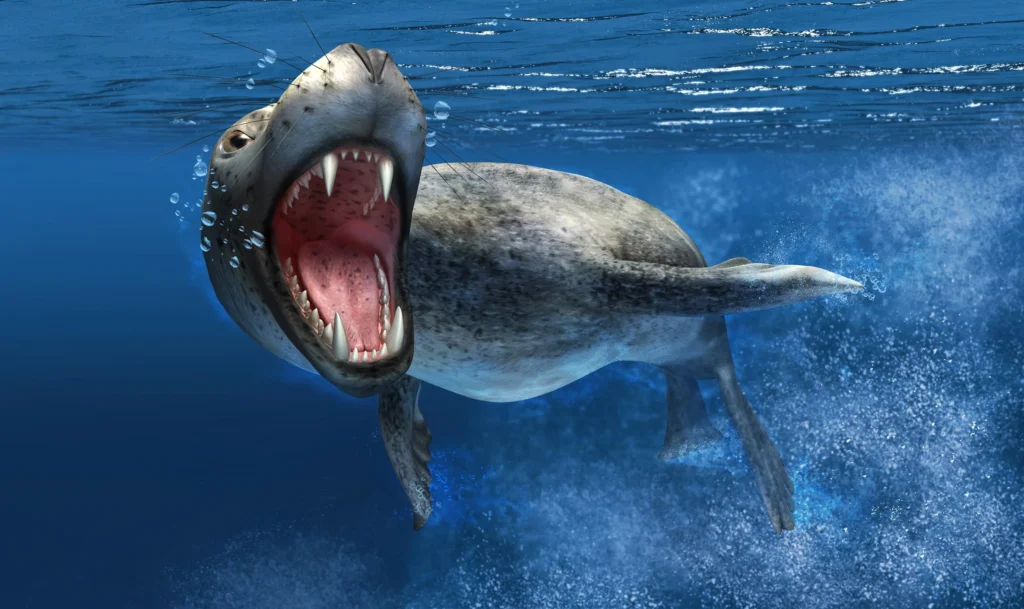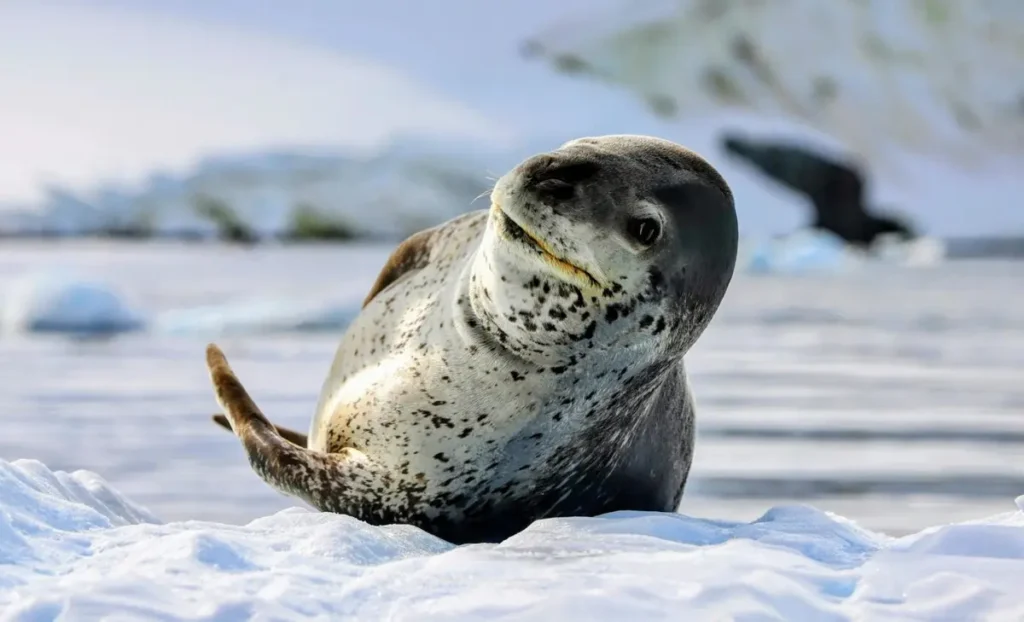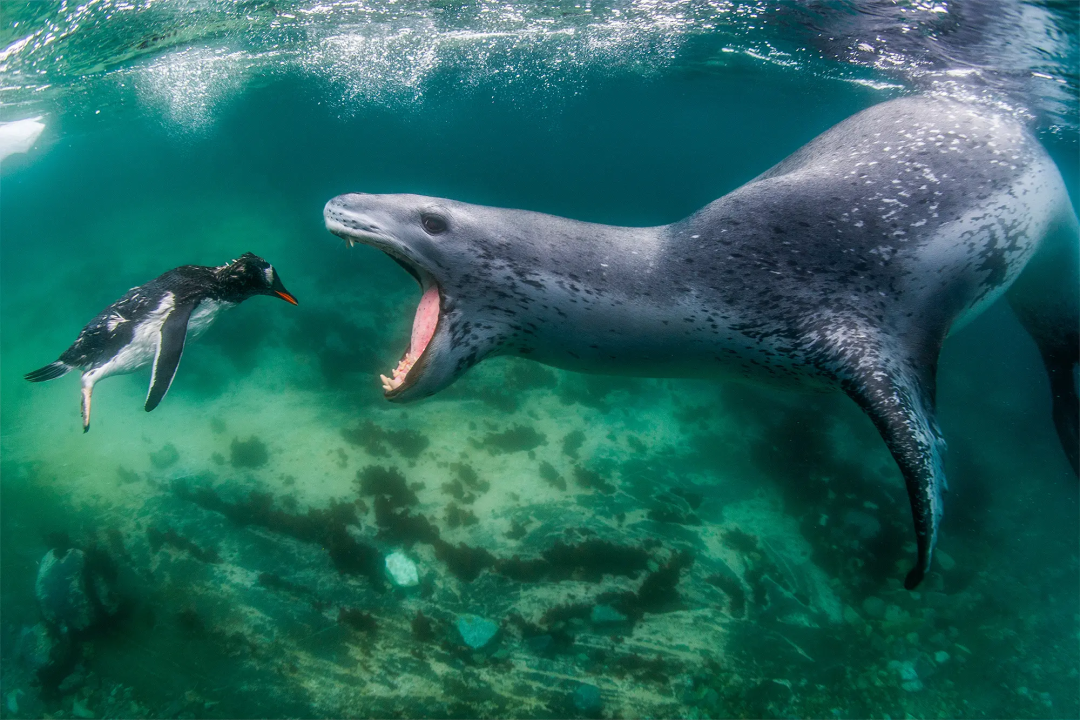Few Antarctic animals inspire the same mix of awe and unease as the leopard seal (Hydrurga leptonyx). Sleek, spotted, and armed with a mouthful of slicing canines, it sits near the top of the Southern Ocean food chain—yet even this formidable hunter must stay alert for larger foes. This guide examines every side of the equation: who eats leopard seals, what they eat themselves, and why it matters for the polar ecosystem.
1. Quick-Fire Facts
| Trait | Detail | SEO Nugget |
|---|---|---|
| Status | IUCN “Least Concern” | Climate-ice dependency |
| Top Speed | 38 km h⁻¹ (24 mph) bursts | Helps ambush penguins |
| Length / Weight | Up to 3.5 m, 590 kg | Sexual dimorphism (females larger) |
| Only Natural Predator | Orca | True apex mammal in most encounters |
2. Do Leopard Seals Have Predators?

Bottom line: Orcas are the single confirmed natural predator; rare observations suggest large sharks or enraged elephant-seals may injure or kill them, but these events are exceptional.
2.1 Killer Whales (Orcas)
Coastal Type-B1 killer-whales occasionally coordinate attacks, tipping seals off floes or striking in open water. Even then, a healthy adult leopard seal is agile enough to escape most pursuits.
2.2 Competitive Pressure, Not Predation
Elephant seals and leopard seals share haul-out zones. Fights can be brutal, yet evidence of regular predation is scant; these clashes are better viewed as territorial disputes.
3. The Leopard Seal Menu: From Krill to Seals
Despite “apex” status, leopard seals exploit every available calorie niche—a trait that buffers them against seasonal food crashes.
| Prey Category | Share in Diet | Hunting Notes |
|---|---|---|
| Antarctic Krill | Up to 45 % of annual intake | Filtered with inter-locking molars—whisker sensors detect swarms. |
| Fish & Squid | Year-round staples | Quick lunges in mid-water; suction feeding. |
| Penguins (Adélie, Gentoo, Emperor) | Peak in summer colonies | Ambush under ice edges; violent surface thrashing. |
| Other Seals (crabeater pups, Weddell juveniles) | Seasonal, high-fat meal | Often target inexperienced pups. |
4. Killer Techniques: How They Hunt
4.1 Ambush & Burst Speed
Leopard seals use shadowed ice shelves as blinds, launching upward strikes that can reach penguins mid-air.
4.2 “Shake-and-Flay” Method
Once caught, prey is whipped against the water to tear skin and feathers—a gruesome but efficient butchering process.
4.3 Dual-Mode Dentition
- Canines (≈2.5 cm): Grip and pierce large prey.
- Lobed Molars: Snap shut to form a sieve for krill.
5. Ecological Role & Food-Web Impact
- Regulation of Penguin Colonies: Predation pressure can shape fledgling success rates, indirectly influencing nutrient cycling from guano.
- Balancing Krill Grazers: By preying on crabeater pups, leopard seals may indirectly modulate the planet’s largest krill consumer, maintaining krill biomass stability.
- Competitor Control: Their presence forces Weddell and Ross seals into niche separation on ice shelves.
6. Human Encounters & Misconceptions
Leopard seals’ famous “smile” belies an unpredictable temperament. While most dive-tour sightings are benign—and sometimes curious, as in the case of photographer Paul Nicklen—fatal aggression has occurred. Safe viewing distances and minimal noise are essential for responsible tourism.
7. Conservation Outlook
- Sea-Ice Reliance: Pack-ice loss reduces birthing platforms and hunting cover.
- Food-Chain Cascades: Krill declines tied to warming waters could push seals toward riskier seal-pup predation.
- Monitoring Needs: Acoustic surveys and satellite tags remain the best tools for population estimates in such a solitary species.
8. Frequently Asked Questions
Q1. Are leopard seals truly apex predators?
Yes—with the notable exception of orcas, adult leopard seals have no routine natural enemies, making them apex within most local food webs
Q2. What is the most common prey of leopard seals?
Diet seasonally shifts, but krill and penguins dominate; krill can reach 45 % of annual consumption.
Q3. Why do they sometimes “play” with prey?
Researchers believe the “cat-and-mouse” chase hones hunting skills or simply provides stimulation in an otherwise solitary life.
Q4. How does climate change affect leopard seal predators and prey relations?

Reduced sea-ice diminishes haul-out spots for penguins and seals, altering prey availability; it also forces leopard seals into open water where orca encounters become more likely.
Q5. Have leopard seals ever been domesticated or kept in aquaria?
Their size, aggression, and need for vast, cold-water territories make them unsuitable for captivity; public aquaria house other, less-aggressive pinniped species instead.
Key Takeaway
Understanding leopard seal predators and prey reveals a delicately balanced system: a carnivore versatile enough to filter krill yet powerful enough to tackle other seals, while itself staying vigilant for orcas. Protecting the Antarctic food web means safeguarding both ends of that spectrum—ice for the prey and space for the predator.

